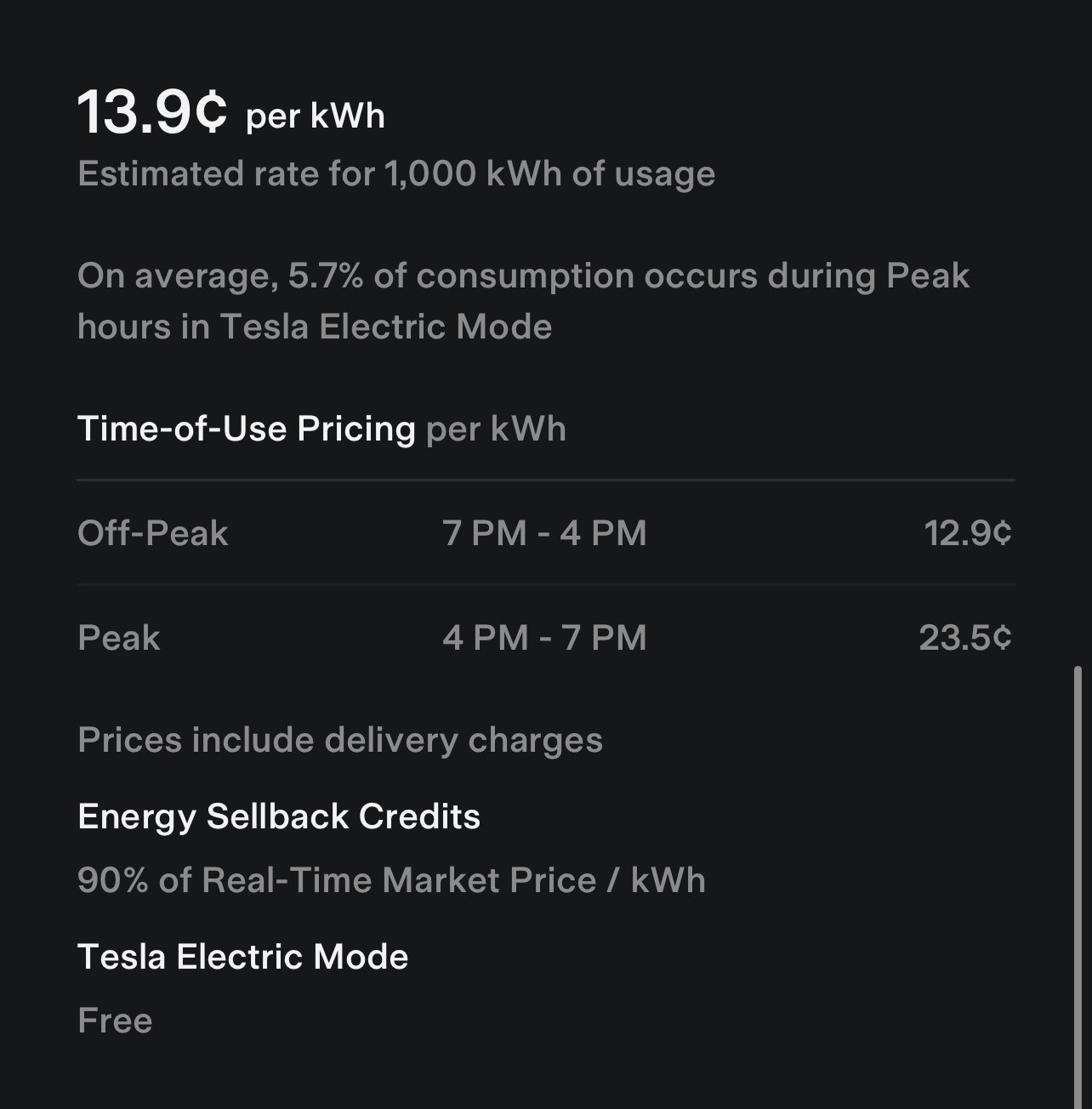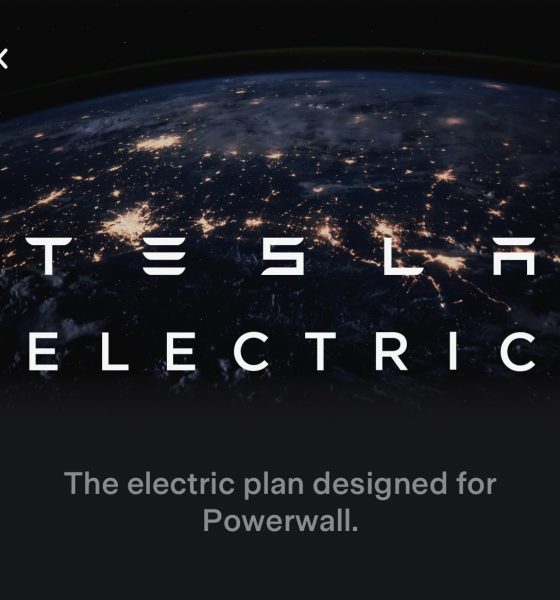Tesla just launched Tesla Electric for Texas. Tesla’s U.S. Energy Markets Policy Lead, Arushi Sharma Frank, and her team, worked tirelessly with the Texas utility and the Texas Public Utility Commission (PUC) to make this happen.
Earlier this year, Tesla Energy participated in several meetings and hearings with the utilities to demonstrate how a virtual power plant (VPP) would positively impact the state. VPPs would allow homeowners with Tesla Powerwall to help reduce the stress on the state’s fragile grid by allowing for extra renewable generated energy to be sent back to the grid.
Prior to this launch, the ERCOT board of directors unanimously approved a pilot project that allows Tesla VPPs.
Alex Guichet, head of Tesla’s Mobile App Product, tweeted on Thursday that he was “really excited to ship this: Tesla Electric in Texas, a retail electricity offer with real-time pricing for Solar and Powerwall exports.”
“It’s a pretty competitive rate offer. It has a peak pricing structure, but Powerwall and Tesla Electric Mode are your buffers to avoid peak prices,” he said.
Credit: Alex Guichet/Tesla
“And the best part of all: you can see the community power flow real-time, including Tesla’s sustainable power sources (in Texas) feeding your home,” he added.
Credit: Alex Guichet/Tesla
Arushi Sharma Frank also added her thoughts about the new launch.
“The pathway for VPP in Texas starts here. There are thousands of distributed megawatts that can be leveraged to solve grid challenges in Texas. And consumers will drive this revolution. Congratulations to the launch team.”
Tesla Energy has introduced Tesla Electric for Texas!
Powerwall owners with a retail choice in Texas can save on electricity bills. “You earn credits toward your bill when you contribute energy stored in your Powerwall to buffer the grid” 🧵https://t.co/OGcpDBRQKd pic.twitter.com/6ZXSATrwQM
— Gail Alfar (@GailAlfarATX) December 15, 2022
Tesla’s new website for its Telsa Electric encourages Tesla Powerwall owners in Texas to sign up.
“If you’re a Powerwall owner with retail choice in Texas, you can save on your electricity bills. You earn credits toward your bill when you contribute energy stored in your Powerwall to buffer the grid. As a member, you can also monitor the sources of your electricity supply 24/7 in the Tesla app and ensure that any electricity you use from the grid is offset with 100 percent Texas-generated renewable energy. On average, Tesla Electric members have the potential to earn over 50 percent more in credits on their electricity bills compared to similar plans,” Tesla said.
For owners wanting to sign up, Tesla Electric is only available in select U.S. States. In Texas, owners need to live in an area of the state that offers retail choice and has a Powerwall installed at their home.
“To see if this plan is available for you, look for the Tesla Electric banner in the Tesla app,” Tesla said.
Disclosure: Johnna is a $TSLA shareholder and believes in Tesla’s mission.
Your feedback is welcome. If you have any comments or concerns or see a typo, you can email me at johnna@teslarati.com. You can also reach me on Twitter at @JohnnaCrider1.
Teslarati is now on TikTok. Follow us for interactive news & more. Teslarati is now on TikTok. Follow us for interactive news & more. You can also follow Teslarati on LinkedIn, Twitter, Instagram, and Facebook.

News
Tesla starts showing how FSD will change lives in Europe
Local officials tested the system on narrow country roads and were impressed by FSD’s smooth, human-like driving, with some calling the service a game-changer for everyday life in areas that are far from urban centers.

Tesla has launched Europe’s first public shuttle service using Full Self-Driving (Supervised) in the rural Eifelkreis Bitburg-Prüm region of Germany, demonstrating how the technology can restore independence and mobility for people who struggle with limited transport options.
Local officials tested the system on narrow country roads and were impressed by FSD’s smooth, human-like driving, with some calling the service a game-changer for everyday life in areas that are far from urban centers.
Officials see real impact on rural residents
Arzfeld Mayor Johannes Kuhl and District Administrator Andreas Kruppert personally tested the Tesla shuttle service. This allowed them to see just how well FSD navigated winding lanes and rural roads confidently. Kruppert said, “Autonomous driving sounds like science fiction to many, but we simply see here that it works totally well in rural regions too.” Kuhl, for his part, also noted that FSD “feels like a very experienced driver.”
The pilot complements the area’s “Citizen Bus” program, which provides on-demand rides for elderly residents who can no longer drive themselves. Tesla Europe shared a video of a demonstration of the service, highlighting how FSD gives people their freedom back, even in places where public transport is not as prevalent.
What the Ministry for Economic Affairs and Transport says
Rhineland-Palatinate’s Minister Daniela Schmitt supported the project, praising the collaboration that made this “first of its kind in Europe” possible. As per the ministry, the rural rollout for the service shows FSD’s potential beyond major cities, and it delivers tangible benefits like grocery runs, doctor visits, and social connections for isolated residents.
“Reliable and flexible mobility is especially vital in rural areas. With the launch of a shuttle service using self-driving vehicles (FSD supervised) by Tesla in the Eifelkreis Bitburg-Prüm, an innovative pilot project is now getting underway that complements local community bus services. It is the first project of its kind in Europe.
“The result is a real gain for rural mobility: greater accessibility, more flexibility and tangible benefits for everyday life. A strong signal for innovation, cooperation and future-oriented mobility beyond urban centers,” the ministry wrote in a LinkedIn post.
News
Tesla China quietly posts Robotaxi-related job listing
Tesla China is currently seeking a Low Voltage Electrical Engineer to work on circuit board design for the company’s autonomous vehicles.

Tesla has posted a new job listing in Shanghai explicitly tied to its Robotaxi program, fueling speculation that the company is preparing to launch its dedicated autonomous ride-hailing service in China.
As noted in the listing, Tesla China is currently seeking a Low Voltage Electrical Engineer to work on circuit board design for the company’s autonomous vehicles.
Robotaxi-specific role
The listing, which was shared on social media platform X by industry watcher @tslaming, suggested that Tesla China is looking to fill the role urgently. The job listing itself specifically mentions that the person hired for the role will be working on the Low Voltage Hardware team, which would design the circuit boards that would serve as the nervous system of the Robotaxi.
Key tasks for the role, as indicated in the job listing, include collaboration with PCB layout, firmware, mechanical, program management, and validation teams, among other responsibilities. The role is based in Shanghai.
China Robotaxi launch
China represents a massive potential market for robotaxis, with its dense urban centers and supportive policies in select cities. Tesla has limited permission to roll out FSD in the country, though despite this, its vehicles have been hailed as among the best in the market when it comes to autonomous features. So far, at least, it appears that China supports Tesla’s FSD and Robotaxi rollout.
This was hinted at in November, when Tesla brought the Cybercab to the 8th China International Import Expo (CIIE) in Shanghai, marking the first time that the autonomous two-seater was brought to the Asia-Pacific region. The vehicle, despite not having a release date in China, received a significant amount of interest among the event’s attendees.
Elon Musk
Elon Musk and Tesla AI Director share insights after empty driver seat Robotaxi rides
The executives’ unoccupied tests hint at the rapid progress of Tesla’s unsupervised Robotaxi efforts.

Tesla CEO Elon Musk and AI Director Ashok Elluswamy celebrated Christmas Eve by sharing personal experiences with Robotaxi vehicles that had no safety monitor or occupant in the driver’s seat. Musk described the system’s “perfect driving” around Austin, while Elluswamy posted video from the back seat, calling it “an amazing experience.”
The executives’ unoccupied tests hint at the rapid progress of Tesla’s unsupervised Robotaxi efforts.
Elon and Ashok’s firsthand Robotaxi insights
Prior to Musk and the Tesla AI Director’s posts, sightings of unmanned Teslas navigating public roads were widely shared on social media. One such vehicle was spotted in Austin, Texas, which Elon Musk acknowleged by stating that “Testing is underway with no occupants in the car.”
Based on his Christmas Eve post, Musk seemed to have tested an unmanned Tesla himself. “A Tesla with no safety monitor in the car and me sitting in the passenger seat took me all around Austin on Sunday with perfect driving,” Musk wrote in his post.
Elluswamy responded with a 2-minute video showing himself in the rear of an unmanned Tesla. The video featured the vehicle’s empty front seats, as well as its smooth handling through real-world traffic. He captioned his video with the words, “It’s an amazing experience!”
Towards Unsupervised operations
During an xAI Hackathon earlier this month, Elon Musk mentioned that Tesla owed be removing Safety Monitors from its Robotaxis in Austin in just three weeks. “Unsupervised is pretty much solved at this point. So there will be Tesla Robotaxis operating in Austin with no one in them. Not even anyone in the passenger seat in about three weeks,” he said. Musk echoed similar estimates at the 2025 Annual Shareholder Meeting and the Q3 2025 earnings call.
Considering the insights that were posted Musk and Elluswamy, it does appear that Tesla is working hard towards operating its Robotaxis with no safety monitors. This is quite impressive considering that the service was launched just earlier this year.










